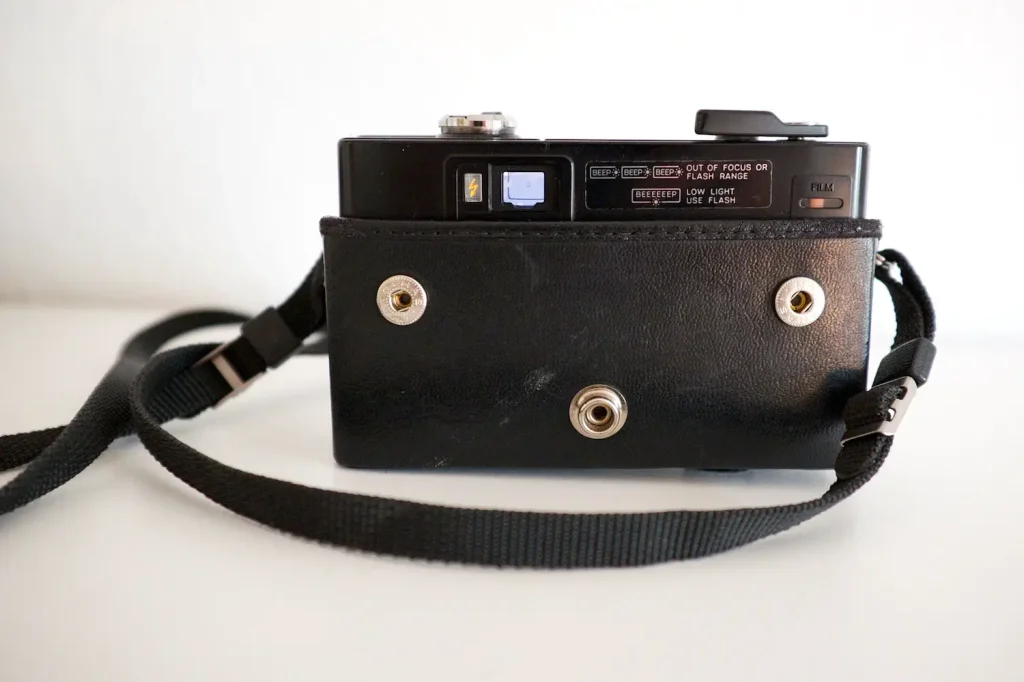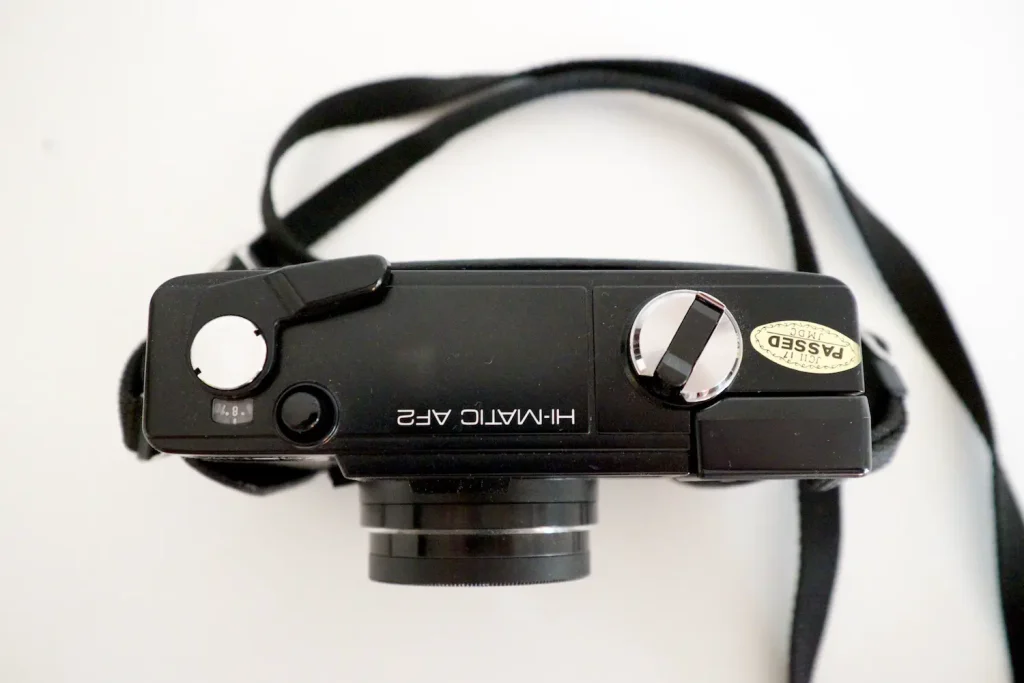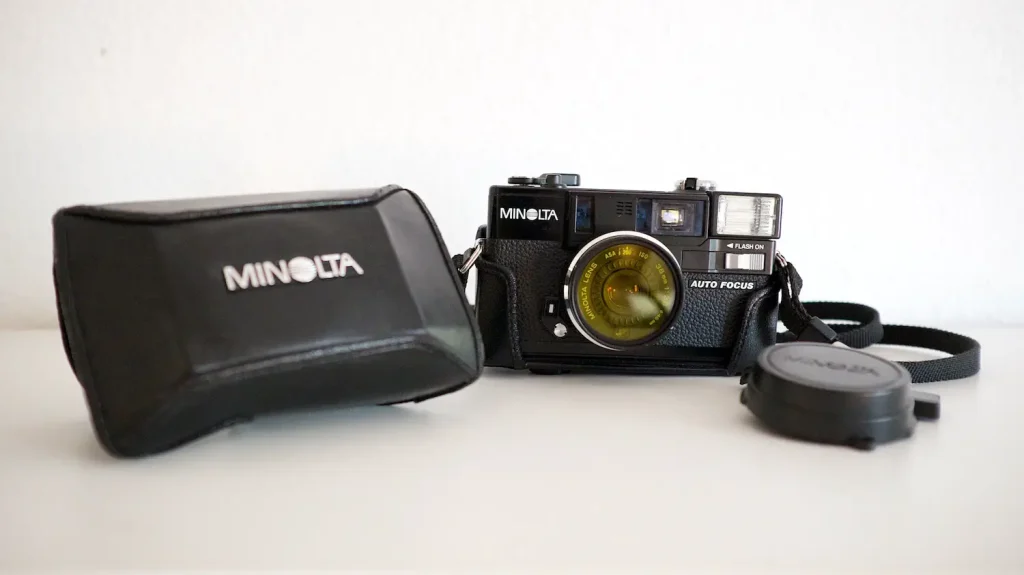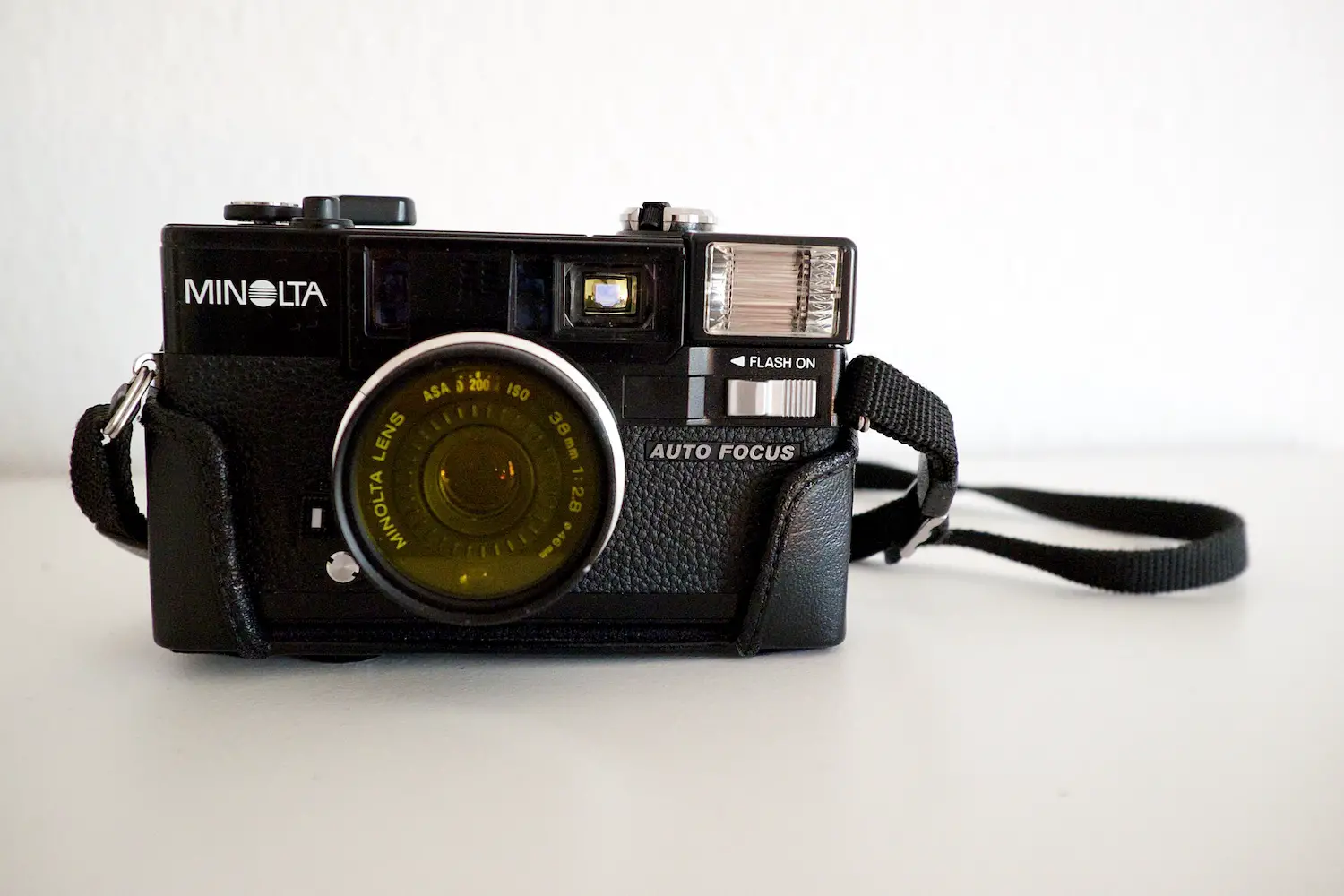Look at that, my second review for this site: the Minolta Hi-Matic AF2. It is not the most compact of compacts, and it’s a bit off an odd beast, having autofocus but manual film advance and rewind. It’s clearly stuck between two ages of photography.
Why another Minolta? The brand is close to my heart, mostly because I like the way their lenses render, but also because, having withdrawn from the photography market, it’s a bit of a scrappy underdog in today’s analog camera world. I always like that. Who doesn’t? Remember the Titans anyone? Minolta seems to have been on the more inventive side of the spectrum when it comes to Japanese camera makers in the mid- and late twentieth century. They often led the way with cool, new things. In hindsight it appears that’s what doomed them. Either Minolta popularized something that became the wave of the future – super bright focusing screens, auto-exposure for Leica M-mount cameras, or autofocus – or they shot themselves in the foot so severely that it makes you wonder if Japan’s strict gun control laws are there mainly to save Minolta executives from themselves. (I kid because I love. You will have to pry my Minolta Autocord from my cold, dead, hands.)

How ever that may be, gentle skimmer of these lines, the 1985 Minolta 7000 was pretty much the first true bred autofocus SLR. It’s not too bad in use today either. Which, I suppose, is why Minolta was sued for infringing on autofocus patents. I will wildly speculate that in their earliest generation AF cameras, they used some straightforward and actually working methods someone had already gotten a patent for because they were straightforward and actually working. That’s why, when I pick up my Minolta 7000, autofocusing is a bit slow and gets fooled here and there, but is generally very usable. My 1988 Nikon F-801 on the other hand, whirrs and wheezes, does a whole dance, and in the end decides to focus on the couch behind you. This, by the way, and I just mention it in passing because you’re obviously not on this site for SLR buying advice, was pretty much fixed with the slightly newer and slightly more downmarket F-601, and finally, on my favorite Nikon, the F-801s, which I’ve found to be on par or even better than the Minolta 7000. It must be said, though, that the F-801s is also five years newer. The control layout of the Nikons and their general size and construction allows you to kid yourself into thinking you don’t sound like a paranoid nut when you mutter to yourself: “Huh, looks like a cross between the Minolta 7000 and an F3.” Maybe with some Canon Colani-designed rounded corners action going on as well. For Nikon as well as Minolta, who eventually settled their autofocusing legal troubles, somewhere between shameless copying and genuine creativity, invention lies. And no, I have no evidence for any of this. But I do have a very stylish tin foil hat. (Or is that pronounced aluminium now?)

Less useful features, of the very kind that required bandages to be shipped in bulk to Minolta HQ at the foot of Mount Rokko, were: motor zoom (for those of us who find that using up battery while zooming in or out at a much slower pace than just turning a ring with your own muscle power is in any way an improvement), auto motor zoom (where the camera thinks it’s intelligent enough to know what you want to zoom on in your picture and does it for you. Nice idea in theory, but if you’ve ever complained about Siri on your iPhone being too dumb and inflexible to use in 2015, imagine how often a runaway zooming servo on a 90s compact would actually do what you wanted it to do), or the infamous “card” system to add exposure modes and special effects to your pictures not by just setting a setting or dialing a dial, but by going out and investing some extra money in a “portrait” card so you could take portraits with your camera, which in itself was perfectly able to take portraits already. I shudder at the power of marketing departments sometimes…
Sorry, lost my train of thought there. TL;DR for the above paragraphs: I like Minolta. They’re weird.

The Minolta Hi-Matic AF2 is a good sized camera. And I mean that in both the sense that it is well-proportioned and feels like it’s a good size in your hand, and in the sense that it’s quite a bit larger than a small point-and-shoot. While the Riva Mini is my designated color film camera, always waiting for its moment in the limelight in a jacket pocket somewhere, the Hi-Matic AF2 is my black and white shooter. (You’ll notice a few color images in this review from when I first tested it out, and a few black and whites taken without a yellow filter before I had gotten one.) It’s larger and it has its own eveready type bag, which I think you needed to buy with the camera. Most of the ones you see for sale come with the bag, either way. Mine also came with two aftermarket conversion lenses, one slight tele, and one slight wide. I’ve compared it to the Fuji X100s before, and while the thought may seem preposterous, there’s something to it, apart from the screw-in add-on lenses. The two are certainly of a comparable size, and they both have 35mm focal length equivalent-ish fixed lenses that are much better than you’d expect.

Why black and white? The Hi-Matic AF2 has a filter thread. At 46mm, it’s not an overly common one, but it’s one that you can easily step up to the 49mm found on more modern Minolta SLR lenses (and, I suppose, to as large as you want, if you’re not afraid of looking silly). In practice, I bought a 46mm medium yellow filter and a 46mm ND4 neutral gray filter, and I use these on this AF2, my Hi-Matic F, and also my XL-601 Super 8 camera. The latter, while compact, is not 35mm, so won’t be making a cameo here soon. Aside from these filters, I don’t need anything else for the Hi-Matic AF2. “The what now?” you ask, “He’s all into that filter thread, and then he just uses it for two filters ever? No even a UV one? ‘splainy?” Ok, imaginary interlocutor who is most likely from California ca. 1997, I will explain.

The gist of it is: most of your easily available black and white films look better when shot through a medium yellow filter. (It’s ok, black and white experts, “well, actually” me here. I stand by that sentence in the same way I’d wear an 85% jacket in the rain: it’s good enough for most people in most circumstances, certainly on a point-and-shoot.) And the ND filter? It steals two stops of light. So if I load my camera with ISO 400 film – my usual choice for the Hi-Matic AF2 – and then step out into a bright summer day and find myself wanting to take a portrait or generally blur out the background, I screw on the ND. The exposure sensor sits under the filter thread, so the Hi-Matic AF2 will meter correctly when you apply a filter. I can’t swear to it, but it seems to me that the AF2’s all auto exposure system will open up the aperture before it reduces the shutter speed, so the ND filter will effectively force a shot that would have been f5.6 and 1/125 into f2.8 and 1/125. This kind of behavior would track with the program mode on the Minolta X-700, introduced to the market not much later. Maybe it doesn’t work like that at all, but this is the effect I’ve found in my testing. Nota bene, that’s the kind of real-world out-of-the-lab kind of testing which proudly would not even pass the “is it really science?” test you mentally apply to an average episode of Mythbusters. So your mileage may well vary. All I can say is: it works for me.

What’s great about the Minolta Hi-Matic AF2, apart from its filter thread? It’s the same things that make it such an odd duck. It is a fully automatic, can’t-set-anything compact 35mm camera from the 1980s. It has all the niceties: a pop up flash, a self timer, and an electronic beep that bravely attempts to save you from underexposed shots. Ok, that one’s both in the pro and con column. It takes two AA batteries. This should be the law. I have no idea how many different kinds of lithium rechargeables and non-rechargeables I’ve had to buy just to be able to test one camera that turned out to not have been worth it. In my perfect world of vintage cameras, everything would take either SR44 1.55V cells, AA batteries, or AAA batteries. With everything else, you’re just making life complicated for hard-working people wanting to take a Sunday stroll with a piece of vintage photographica. Even my favorite, the Riva Mini gets this wrong. There, I’ve said my peace.

So pop in the AA batteries, and thread in the film – yup, it’s thread-in-film old – and close the back. If you point the camera at something and it beeps at you, it’s time to either snap the flash into its popped up position (a very satisfying “clack” that makes), or to try your luck not shaking too much. The lens is a super useful 38mm focal length, and it goes down to f2.8. That’s not stellar in terms of aperture (my Canon AF35ML has a 40mm/f1.9), but it’s good. Then frame your subject, using the single autofocus spot in the middle, which works fine as long as you can see your subject. No LED: good, red LED: bad. There’s also an LED indicator in the nicely bright viewfinder that shows you whether the camera is focusing near or far, which is great if you take off-center portraits of people and want to make sure their face is in focus rather than the duck pond behind them. The focusing is usable, but it’s ultimately why you’ll want another camera besides the Hi-Matic AF2 to do similar things with. The AF2’s claim to fame is that it was one of the (if not the) first compact with active infrared autofocus. I’m not sure that matters much. I tried some night shots with flash and the Hi-Matic AF2 had no idea where it should focus. Unhelpfully, it fired anyway, blinding everyone around in addition to wasting a frame. Luckily, you’ll never know when you look at the photos, because they’re all a blur.

Even when you don’t take an unfocused flash picture, you may at first be a bit disappointed. The Hi-Matic AF2 snaps pictures pretty much immediately upon depressing the button, but it makes a strangely lifeless “thwash” sound as the leaf shutter opens and closes. If a robot could sneeze, that’s the sound it would make. Quickly, however, this grows on you. Because it’s very quiet. Also, this leaf shutter means high flash sync speed. Daylight fill flash: check. It’s not foolproof, however. I’ve found at least one instance of the flash generously exposing for a white shirt in the foreground and thus blowing it out completely. With the flash turned off (simply press it down and don’t slide the flash lock button when it beeps at you), the Hi-Matic AF2 is unobtrusive. It’s reportage. It’s fly-on-the-wall.

Which brings me to my favorite game, “Who and what is this one good for?” It’s good for you if you want a camera with modern conveniences but manual charm (build quality is good, but Minolta’s rangefinder Hi-Matics from the 70s were better; there’s plastic here, I won’t lie). It’s for you if you like the idea of autofocus but don’t like the idea of auto film advance. If you’ve always wanted a Canon AF35ML or Nikon L35AF but couldn’t stand the fact that a motor would advance the film for you, the Hi-Matic AF2 is for you. The AF2 is for you if you want a camera that’s comfortable to hold and will enable you to take shots at slower speeds than a compacter compact maybe would. It’s for you if you like to use filters, the ones I prefer or any other kind.

The Minolta Hi-Matic AF2 is for you if you like good lenses. It has a darn good lens. I bury the lede here. For a compact, or any camera, it has a really good lens. I especially like it on black and white photos. They’re generally well exposed, with or without flash. There’s more bokeh here than I would have expected, and it’s nice bokeh. Images have a timeless quality. They glow like old prints from a Rolleiflex. I wax poetic – but there really is a certain something about pictures from the Hi-Matic AF2 I haven’t gotten with any other lenses – except the one on my Minolta Autocord TLR. The Riva Mini is sharp and looks good, but there’s a final little something missing in comparison with this one. Minolta’s SLR lenses are sharp and make beautiful pictures, but the only one that has the je-ne-sais-quoi of the AF2’s fixed lens is the 35/f2.8. Maybe someone more versed in lens design can point as to why that is. What I can say is that the images that come out of this camera look great.

As for the con column: The Minolta Hi-Matic AF2 not for you if you’re expecting full manual control. Your control is pretty much over whether you take a picure or not, and whether you want to use flash or not. And that’s it. It’s not for you if you don’t want or need a compact camera that’s not really all that compact. I mentioned the Nikon EM in my Riva Mini review. The Hi-Matic AF2 isn’t really much smaller than that. Many of the Hi-Matic rangefinders that came before the AF2 are considerably smaller.

The Hi-Matic AF2 is an old camera in new clothes, stuck between two paradigms. It makes sense to regard it as if it was an artefact that needs to be fitted into a timeline, much like in evolutionary biology. You see it, and you can surmise how we got from all-manual rangefinders to all-auto compacts. It hasn’t completely shed its fins, and hasn’t quite developed legs yet. But it’s a viable life form all the same.
That said, if one comes your way and you’re in the market for, well, make up your own category here, then get the Hi-Matic AF2. It’s good for what it is, and brilliant for some purposes.
Quick technical note: The foam light seals on any AF2 that has not been serviced since its original purchase will pretty much have disintegrated. It’s the easiest light seal replacement I’ve ever done. It’s also not strictly necessary to replace if you keep the bag on. Remove the seals and go from there. As long as you can wield a toothpick, a q-tip and some string, don’t worry about it.
Share this post:









Comments
David Overton on Minolta Hi-Matic AF2 Review – A Camera Between the Ages – by Torsten Kathke
Comment posted: 21/10/2015
jeremy north on Minolta Hi-Matic AF2 Review – A Camera Between the Ages – by Torsten Kathke
Comment posted: 21/10/2015
jojonas on Minolta Hi-Matic AF2 Review – A Camera Between the Ages – by Torsten Kathke
Comment posted: 23/10/2015
Hamish, you should make so the first time Riva Mini is mentioned, it links to the guest review of that :)
Torsten Kathke on Minolta Hi-Matic AF2 Review – A Camera Between the Ages – by Torsten Kathke
Comment posted: 23/10/2015
Comment posted: 23/10/2015
Comment posted: 23/10/2015
New Review – Minolta Hi-Matic AF-2 (Over on 35mmc.com) on Minolta Hi-Matic AF2 Review – A Camera Between the Ages – by Torsten Kathke
Comment posted: 23/10/2015
cs on Minolta Hi-Matic AF2 Review – A Camera Between the Ages – by Torsten Kathke
Comment posted: 07/12/2015
Comment posted: 07/12/2015
Martina on Minolta Hi-Matic AF2 Review – A Camera Between the Ages – by Torsten Kathke
Comment posted: 21/02/2016
Comment posted: 21/02/2016
Ray Liu on Minolta Hi-Matic AF2 Review – A Camera Between the Ages – by Torsten Kathke
Comment posted: 31/03/2016
Here's some shots using the Minolta Hi-Matic AF2 https://www.flickr.com/photos/tkrliu/albums/72157665561538566
Kim on Minolta Hi-Matic AF2 Review – A Camera Between the Ages – by Torsten Kathke
Comment posted: 29/06/2017
Sarah on Minolta Hi-Matic AF2 Review – A Camera Between the Ages – by Torsten Kathke
Comment posted: 04/08/2017
Torsten Kathke on Minolta Hi-Matic AF2 Review – A Camera Between the Ages – by Torsten Kathke
Comment posted: 05/08/2017
Chris Bates on Minolta Hi-Matic AF2 Review – A Camera Between the Ages – by Torsten Kathke
Comment posted: 28/09/2017
Comment posted: 28/09/2017
jeph foust on Minolta Hi-Matic AF2 Review – A Camera Between the Ages – by Torsten Kathke
Comment posted: 24/04/2018
Gordon Palmer on Minolta Hi-Matic AF2 Review – A Camera Between the Ages – by Torsten Kathke
Comment posted: 22/04/2019
Valerie Q on Minolta Hi-Matic AF2 Review – A Camera Between the Ages – by Torsten Kathke
Comment posted: 12/05/2019
Comment posted: 12/05/2019
Camera Review – Minolta Himatic AF2 – Aragon's Eye on Minolta Hi-Matic AF2 Review – A Camera Between the Ages – by Torsten Kathke
Comment posted: 21/05/2019
Legentil jean-marc on Minolta Hi-Matic AF2 Review – A Camera Between the Ages – by Torsten Kathke
Comment posted: 29/01/2020